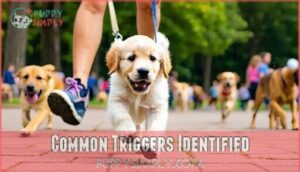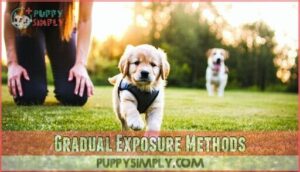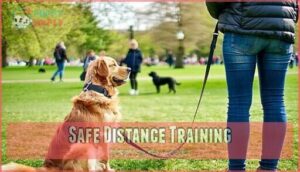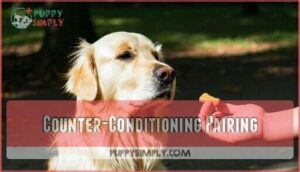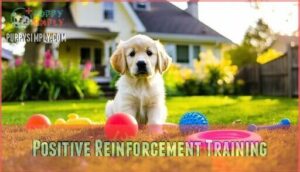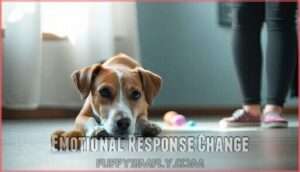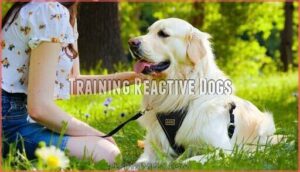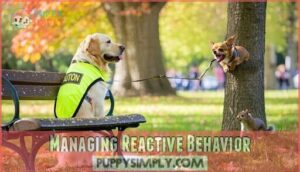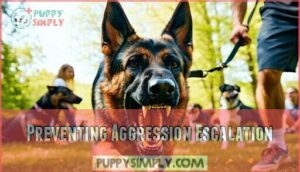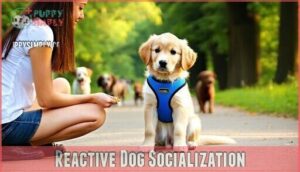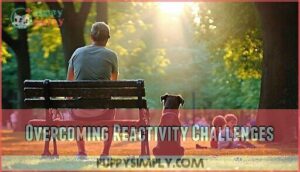This site is supported by our readers. We may earn a commission, at no cost to you, if you purchase through links.
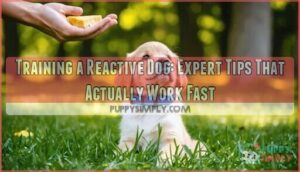 Training a reactive dog starts with understanding they’re not "bad"—they’re scared or overwhelmed.
Training a reactive dog starts with understanding they’re not "bad"—they’re scared or overwhelmed.
Your pup needs distance from triggers while you rebuild their confidence through positive associations.
Start counter-conditioning by pairing scary things with amazing treats at a safe distance.
Use high-value rewards like cheese or chicken to change their emotional response from "that’s terrifying" to "that means good things happen."
Management is key—avoid putting your dog in situations where they’ll fail.
Practice pattern games and emergency U-turns to redirect their focus back to you.
Most reactive dogs can learn to feel safer with consistent, patient training that respects their comfort zone.
Table Of Contents
- Key Takeaways
- What is Reactivity
- Common Triggers Identified
- Desensitization Techniques
- Counter-Conditioning Strategies
- Training Reactive Dogs
- Managing Reactive Behavior
- Preventing Aggression Escalation
- Reactive Dog Socialization
- Overcoming Reactivity Challenges
- Frequently Asked Questions (FAQs)
- How do I retrain a reactive dog?
- How to introduce triggers to reactive dogs?
- What is the best training for reactive dogs?
- Is reactive dog training difficult?
- How do I train my dog to stop being reactive?
- What is the 3 second rule in dog training?
- Can reactive dogs be fully cured?
- How long does reactivity training typically take?
- Should I use shock collars for reactive dogs?
- Are certain dog breeds more prone to reactivity?
- Conclusion
Key Takeaways
- Your dog’s reactivity stems from fear, not defiance – They’re overwhelmed and scared, not trying to be difficult, so you’ll need patience and understanding rather than punishment to help them feel safer.
- Counter-conditioning changes your dog’s emotional response – You’ll pair scary triggers with high-value treats at a safe distance, gradually teaching your dog that frightening things actually predict good things happening.
- Management prevents setbacks during training – You’ll need to avoid putting your dog in situations where they’ll react by using different walking routes, creating buffer zones, and practicing emergency U-turns before they reach their threshold.
- Consistency and distance work are essential – You’ll start training from far enough away that your dog notices triggers but stays calm, then gradually decrease the distance over weeks or months while maintaining daily practice sessions.
What is Reactivity
Your dog’s explosive reactions to everyday sights aren’t bad behavior—they’re overwhelm signals from a nervous system stuck in overdrive.
Reactivity happens when dogs feel trapped between wanting to escape a trigger and being unable to create distance, leading to that dramatic barking, lunging, or growling you’ve witnessed.
Your dog’s barking isn’t defiance—it’s their nervous system screaming for help.
Fear and Discomfort Causes
Fear drives most reactive behavior in dogs.
Your dog’s explosive outbursts aren’t defiance—they’re desperate cries for help from an overwhelmed nervous system.
Your fearful dog isn’t being "bad" – they’re experiencing genuine terror or discomfort.
Fear-based reactivity often stems from trauma and reactivity cycles, where past negative experiences create lasting anxiety in dogs.
Without early socialization, puppies miss vital learning windows.
High-stress environments amplify these fears, making impulse control nearly impossible for your anxious companion, often leading to a cycle of anxiety.
Genetics and Age Factors
While fear plays a major role, your dog’s reactive behavior might be written in their DNA.
Genetics account for 60-70% of dog reactivity variations, with certain breeds like herding and terrier groups showing higher rates due to selective breeding for alertness.
It’s worth noting that noise sensitivity affects a significant portion of dogs.
- Breed Predisposition: Some breeds inherit reactive tendencies through generations
- Inherited Temperament: Parents’ behavior patterns often appear in offspring
- Age-Related Changes: Most reactivity emerges during 6-18 month adolescence period
- Puppy Socialization: Critical 3-16 week window affects lifelong behavior patterns
- Genetic Testing: DNA analysis can identify predisposition markers for fearbased reactivity
Insufficient Enrichment Effects
Beyond genetic predisposition, boredom reactivity stems from insufficient mental stimulation and unmet exercise needs.
When dogs lack proper enrichment, they develop destructive behaviors and heightened stress responses. Cognitive decline accelerates without adequate challenges, making reactive dog training more difficult.
Understanding your dog’s environment management needs prevents dog reactivity from escalating into serious dog behavior modification issues.
| Enrichment Type | Daily Requirement | Reactive Dog Benefit |
|---|---|---|
| Mental Puzzles | 15-30 minutes | Reduces trigger sensitivity |
| Physical Exercise | 60-90 minutes | Decreases stress hormones |
| Scent Work | 10-20 minutes | Builds confidence naturally |
| Training Sessions | 5-10 minutes | Improves impulse control |
Common Triggers Identified
Understanding your dog’s triggers is the first step to successful training.
Common triggers include people, other animals, moving objects like bikes or cars, and leash restrictions that create frustration when your dog can’t approach what they want to investigate.
People and Animals Triggers
People and animals are your dog’s most common reactive triggers.
Dogs often struggle with "stranger danger" – unfamiliar people wearing hats, sunglasses, or uniforms can spark intense reactions.
Dog-dog reactivity affects over 60% of reactive dogs, with breed predispositions playing a role.
Missed socialization windows during puppyhood and trauma impact create lasting fear responses requiring specialized reactive dog training approaches.
Interdog aggression can also arise from a lack of socialization, requiring owners to understand common stress triggers and address reactive dog issues with proper training and care for lasting fear responses.
Environmental and Object Triggers
Moving objects and sudden changes in your dog’s environment can trigger intense reactions just as quickly as people or animals.
Your dog’s world is full of potential triggers that seem harmless to you but overwhelming to them.
- Moving Objects: Bicycles, skateboards, cars, and even blowing leaves can activate your dog’s chase or fear response
- Sudden Changes: New decorations, tipped trash cans, or rearranged furniture can startle reactive dogs
- Novel Items: Unfamiliar objects like construction equipment or holiday displays often cause trigger stacking
- Breed Predispositions: Some breeds react more strongly to specific environmental stimuli due to their genetics
Understanding these environmental dog aggression triggers helps you practice better dog environment management and more effective reactive dog training.
Leash and Restraint Triggers
Your dog’s leash can become their biggest source of frustration.
That invisible leash becomes a barrier to your dog’s natural instincts.
Restricted movement creates leash reactivity when they can’t approach or escape triggers naturally.
This leash frustration often escalates into leash aggression, making walks stressful for everyone.
Equipment choice matters—harnesses distribute pressure better than training collars.
The right gear reduces these common dog triggers substantially.
Desensitization Techniques
Desensitization works by gradually exposing your dog to triggers at a safe distance where they notice but don’t react.
You’ll slowly decrease the distance over multiple sessions, always keeping your dog calm and comfortable throughout the process.
Gradual Exposure Methods
Gradual exposure methods work like building immunity—you’ll start with tiny doses of your dog’s triggers and slowly increase intensity.
This approach prevents overwhelming your reactive dog while building confidence through incremental progress and threshold awareness.
Positive reinforcement is also vital in training reactive dogs.
- Distance Training: Begin exposing your dog to triggers from across a parking lot or field
- Trigger Ladders: Create a step-by-step hierarchy from easiest to most challenging situations
- Controlled Introductions: Use predictable, structured sessions rather than random encounters
- Progress Tracking: Monitor your dog’s comfort level and adjust exposure accordingly
Safe Distance Training
Finding the right distance from triggers keeps your dog calm and focused.
Start with your dog’s buffer zone—the space where they notice triggers but don’t react.
This threshold awareness prevents overwhelming your pup while building confidence through distance progression.
A useful training tool during this phase can be invaluable.
| Distance Range | Dog’s Response |
|---|---|
| Too Close | Barking, lunging, stress signals |
| Sweet Spot | Alert but calm, can take treats |
| Too Far | Disengaged, not learning |
Watch for calming signals like lip licking or yawning—these tell you you’re pushing too close.
Create safe spaces where your dog can observe without feeling trapped.
Gradually decrease distance as your dog shows comfort, but never rush the process.
Remember, every dog’s buffer zone differs, so let your pup set the pace for successful desensitization training.
Counter-Conditioning Pairing
Once you’ve established safe distance training, you’ll need to change your dog’s emotional response to triggers through counter-conditioning pairing.
This reactive dog training technique creates new trigger associations by pairing the sight of what scares your dog with high-value treats.
Start with consistent application of positive reinforcement when your dog notices triggers but stays calm.
During the generalization phase, you’ll expand this emotional retraining across different environments, building a solid value hierarchy that makes counter conditioning and desensitization training truly effective.
Counter-Conditioning Strategies
You’ll transform your dog’s negative reactions into positive associations by pairing triggers with something they absolutely love.
Counter-conditioning works by rewarding your dog every time they see their trigger, gradually changing their emotional response from "Oh no!" to "Oh boy, treats!
Positive Reinforcement Training
Transform your reactive dog’s behavior by rewarding calm responses around triggers instead of punishing outbursts.
Master reward timing and shaping behavior through consistent positive reinforcement that builds trust while avoiding punishment completely.
- Time rewards precisely when your dog notices triggers but stays calm
- Use reinforcement schedules to maintain consistent progress during counter conditioning
- Apply motivation strategies that match your dog’s energy and interest levels
- Focus on behavior modification plans that celebrate small wins daily
- Practice desensitization techniques alongside rewards for lasting reactive dog training success
High-Value Treats Usage
Your dog’s favorite treats become powerful tools in reactive dog training when you understand treat value hierarchy.
Use high-value treats like cheese, chicken, or freeze-dried liver during counter conditioning sessions.
Perfect your reward timing by delivering treats the moment your dog notices triggers but stays calm.
Consider dietary considerations and treat alternatives to prevent weight gain during intensive positive reinforcement training.
Many owners find success using palatable training incentives to motivate their dogs.
Emotional Response Change
Your reactive dog’s emotional response changes when you consistently pair triggers with positive experiences.
Counter-conditioning replaces fear with anticipation – your dog starts expecting good things instead of bracing for threats.
This emotional shift happens below their threshold, where they notice triggers but stay calm.
Through positive reinforcement and desensitization, you’re rewiring their brain’s automatic reactions, which leads to a significant change in their behavior, ultimately replacing fear with anticipation.
Training Reactive Dogs
When you’re ready to train your reactive dog, you’ll need proven methods that work without causing more stress.
Force-free training combined with patience and consistency creates lasting behavioral changes that benefit both you and your furry friend.
Force-Free Training Methods
Skip harsh corrections and shock collars—your reactive dog needs positive reinforcement, not punishment.
Force-free training builds trust through rewards, treats, and patience.
You’ll create lasting behavior change by working below your dog’s threshold, using engage/disengage techniques.
This approach reduces stress while strengthening your bond, making training sessions enjoyable for both of you.
Holistic Approach Benefits
Beyond traditional training methods, you can enhance your reactive dog’s progress through complementary therapies.
Acupuncture benefits include reduced anxiety and improved emotional wellbeing, while massage therapy helps release physical tension.
Herbal remedies may support calmness when combined with positive reinforcement, desensitization, and counterconditioning.
These holistic approaches address your dog’s complete wellness, not just surface behaviors.
Consistency and Patience
While holistic approaches offer valuable support tools, real progress with your reactive dog depends on two non-negotiable factors: consistency and patience. Rome wasn’t built in a day, and neither is a calm, confident dog.
Here’s your roadmap to lasting success:
- Establish a Daily Routine – Feed, walk, and train at consistent times to build security and predictability
- Track Gradual Progress – Document small improvements weekly rather than expecting overnight transformations
- Set Realistic Expectations – Most reactive dogs need 6-12 months of consistent work before major breakthroughs
- Celebrate Small Wins – Reward yourself when your dog looks at a trigger without barking, even briefly
Remember, dog training consistency beats intensity every time. Your perseverance in maintaining the same approach daily will prevent frustration and build the foundation for long-term success with your reactive dog.
Managing Reactive Behavior
You can’t train away reactive behavior if you’re not managing your dog’s environment first.
Smart management prevents reactive episodes while you work on training, making the whole process faster and less stressful for both of you, which is why smart management is crucial.
Environment Management Tips
Smart dog training environment management starts with creating the right setup.
Use sightline barriers like fences or bushes to block your reactive dog’s view of triggers during walks.
Change walking routes regularly to avoid predictable stressors.
Establish buffer zones by maintaining distance from crowded areas.
Install puzzle feeders to reduce frustration at home.
A good option for reactive dogs is the Ruffwear Front Range Harness for added control.
Maintain a consistent routine—dogs thrive on predictability, making management easier.
Pattern Games and Exercises
Pattern games create predictable movements that comfort anxious dogs while reducing their focus on triggers.
These comforting sequences build confidence and teach alternative behaviors through structured dog training exercises. Many owners find success using specific pattern game tools to enhance their dog’s training.
- "1-2-3 Treat" – Count aloud while your reactive dog performs simple actions, creating rhythm and focus
- "Up-Down" – Guide your dog between standing and lying positions using treats as motivation
- "Look at That" – Point to neutral objects, reward attention, then gradually introduce mild triggers
- "Engage-Disengage" – Let your dog notice triggers briefly, then reward when they look back at you
- "Hand Targeting" – Teach nose-to-palm touches as an incompatible behavior during stressful moments
U-Turn and Heel Cues
U-Turn Benefits teach your reactive dog to pivot away from triggers on command, creating instant distance.
Master heel cue variations by practicing tight turns at different speeds. Combining cues works best when your dog sees the trigger but hasn’t reacted yet.
For cue troubleshooting, reward immediately when your dog responds correctly.
Real-world application means practicing these moves during actual walks, not just training sessions, to ensure your dog can apply what they’ve learned in real-world situations.
Preventing Aggression Escalation
You can’t afford to let your reactive dog’s behavior spiral into full-blown aggression—the stakes are too high for both your pup and everyone around them.
The good news is that with the right vigilance and consistent training, you can keep your dog’s reactions from crossing that dangerous line into aggressive territory.
Vigilance and Protection Measures
You can’t prevent every reactive incident, but staying alert helps you spot trouble before it escalates. Watch for Early Warning Signs like stiff body language or intense staring.
Know your dog’s Buffer Zone Awareness – that invisible space where they feel safe. Emergency Protocols and Muzzle Training aren’t failure; they’re smart preparation.
- Set up a Safe Room Setup where your reactive dog can decompress after stressful encounters
- Practice muzzle training during calm moments so it becomes a positive tool, not punishment
- Learn your dog’s warning signals – ears forward, hackles raised, or that "thousand-yard stare" means trouble’s brewing
Personal Space Respect
Your reactive dog needs a buffer zone—that invisible boundary where they feel safe.
Watch their body language closely for calming signals like lip licking or turning away.
When you notice these signs, create distance immediately, as your handler awareness prevents overwhelming situations.
Respect their comfort zone to guarantee safe interactions and reduce stress triggers.
Continuous Training Plans
Building on respecting your reactive dog’s boundaries, you’ll need a structured approach that evolves with your dog’s progress.
Think of it like learning to ride a bike—you don’t master it in one session.
Your continuous training plan should include:
- Plan Adaptability – Modify desensitization sessions based on your dog’s daily stress levels and environmental changes
- Ongoing Evaluation – Track trigger responses weekly to identify patterns and adjust counterconditioning techniques accordingly
- Skill Maintenance – Practice learned behaviors in new locations to confirm generalization strategies work in real-life integration scenarios
Consistency beats intensity every time with reactive dog training.
Reactive Dog Socialization
Socializing a reactive dog requires careful planning and realistic expectations—you can’t rush the process or force interactions.
Start with controlled environments where you can manage distance and triggers, gradually building your dog’s confidence through positive experiences rather than overwhelming them with too much too soon.
Off-Leash Play Precautions
Most reactive dogs aren’t ready for offleash adventures—think of it like removing training wheels too early.
Start with secure, fenced areas and bring your emergency plan: muzzle, warning gear, and dog spray deterrent as backup.
Master safe recall and boundary training first, and choose quiet locations away from triggers.
Your reactive dog’s freedom depends on hazard awareness and solid preparation.
Socialization Techniques and Tips
Your reactive dog needs smart socialization, not random meetups.
Start with controlled introductions using calm, well-behaved dogs in safe environments. Puppy socialization windows close early, but adult dogs can still learn through desensitization and counterconditioning.
Create positive associations by rewarding calm behavior around triggers. Professional trainers often use helper dogs for predictable scenarios.
Remember, quality beats quantity—one successful interaction trumps ten stressful ones.
Overcoming Reactivity Challenges
Working with a reactive dog can feel overwhelming, but you don’t have to tackle this challenge alone.
Professional trainers and behaviorists bring specialized knowledge that can fast-track your progress and help you avoid common mistakes that might set you back.
Seeking Professional Help
Sometimes the toughest battles need reinforcements. When your reactive dog’s behavior feels overwhelming, certified professionals offer life-changing support.
Dog behavior consultants and veterinary behaviorists can distinguish between fear-based reactivity and aggression, while professional trainers create customized plans.
Medication options through veterinary behaviorists help severe cases, and support groups provide emotional backing. One helpful tool is a front range harness for better control.
Remote consultations make expert help accessible everywhere, providing life-changing support and emotional backing with the use of tools like a front range harness.
Long-Term Success Strategies
Beyond the initial training wins, your reactive dog’s journey requires smart, long-term thinking.
Success isn’t just about quick fixes—it’s about building lasting change.
Here’s your roadmap for sustained progress:
- Consistent Routine – Daily training sessions and predictable schedules create security
- Environmental Control – Manage triggers through strategic route planning and space management
- Ongoing Training – Continue desensitization and counterconditioning work regularly
- Professional Support – Maintain contact with trainers for guidance and owner mindset adjustments
Remember, reactive dog training isn’t a sprint—it’s a marathon worth running.
Frequently Asked Questions (FAQs)
How do I retrain a reactive dog?
Think of your dog’s reactivity as a smoke alarm going off – it’s meant to protect, but it’s way too sensitive.
You’ll need to rewire that alarm through counter-conditioning and desensitization, pairing triggers with treats while staying below your dog’s threshold.
How to introduce triggers to reactive dogs?
Start introducing triggers from a distance where your dog notices but doesn’t react. Gradually decrease distance while pairing the trigger with high-value treats. This builds positive associations slowly and safely.
What is the best training for reactive dogs?
The best training combines desensitization and counter-conditioning—think of it as teaching your dog that triggers mean treats, not trouble.
Toss in patience, positive reinforcement, and consistency, and you’ll see progress, one wag at a time.
Is reactive dog training difficult?
Like trying to untangle Christmas lights in the dark, reactive dog training challenges you but isn’t impossible.
You’ll need patience, consistency, and the right techniques.
Progress takes time, but most dogs improve substantially with proper counter-conditioning and desensitization methods.
How do I train my dog to stop being reactive?
Use desensitization and counter-conditioning by gradually exposing your dog to triggers at safe distances while rewarding calm behavior with high-value treats, creating positive associations instead of reactive responses.
What is the 3 second rule in dog training?
The 3-second rule helps you catch your dog’s attention before they react to triggers.
You’ll mark and reward calm behavior within three seconds of spotting their trigger, preventing reactive episodes from starting, this can be seen as a way to prevent reactive episodes.
Can reactive dogs be fully cured?
Like a puzzle missing pieces, reactive dogs rarely achieve complete "cure" – but they can dramatically improve.
With consistent training using counter-conditioning and desensitization, you’ll likely see significant progress, though some triggers may always require management.
How long does reactivity training typically take?
Reactivity training timelines vary widely, but you’ll typically see initial progress in 2-4 weeks with consistent daily practice.
Most dogs need 3-6 months for significant improvement, though some require ongoing management throughout their lives.
Should I use shock collars for reactive dogs?
Think of shock collars like yelling at someone who’s already scared – it only makes things worse.
Don’t use them for reactive dogs.
They increase fear and can escalate aggression instead of solving the problem.
Are certain dog breeds more prone to reactivity?
Some breeds have genetic tendencies toward reactivity, but any dog can develop these behaviors.
Herding breeds, terriers, and guard dogs often show heightened responses due to their working instincts rather than inherent aggression.
Conclusion
Remember when your dog first started barking at strangers? That moment of panic isn’t gone forever.
Training a reactive dog takes time, but you’ve got the tools now. Counter-conditioning works when you’re patient and consistent.
Your pup can learn that scary things predict good things instead of danger. Start small, celebrate tiny wins, and don’t rush the process.
Most reactive dogs become calmer, happier companions with dedicated training. You’re already on the right path.
- https://www.sniffspot.com/blog/dog-reactivity/definitive-guide-what-is-dog-reactivity
- https://www.reddit.com/r/reactivedogs/comments/d22pr6/i_used_data_from_rreactive_dogs_to_look_into_at/
- https://www.packleaderhelp.com/post/how-to-train-a-reactive-dog
- https://2houndsdesign.com/blogs/blog/tips-for-working-with-a-reactive-dog
- https://www.offleashk9training.com/training-tips-for-reactive-dogs-in-crowded-public-spaces/

